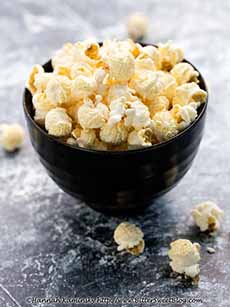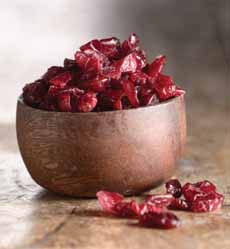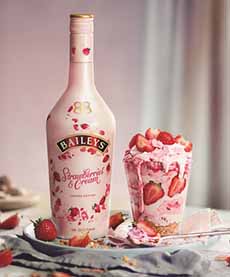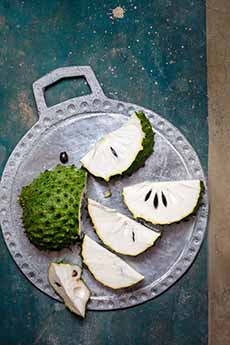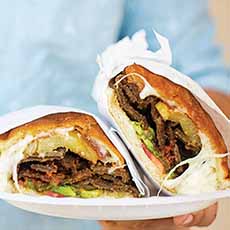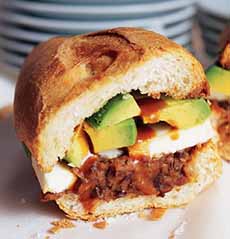|
May 4th is National Orange Juice Day, and Mother’s Day is this Sunday. So here’s a cocktail to celebrate both, made with blood orange juice and gin. You can buy and squeeze your own blood orange juice (photo #3), but it’s easy to find it already squeezed in brands like Mongibello and Natalie’s.
This cocktail has no fancy name, just a generic one (“Blood Orange Thyme And Gin Cocktail’). So unleash your inner mixologist and name it after yourself, your mother, whoever.
Because this recipe came to us from Mongibello, an Italian producer of fresh citrus juices, we called it the…
RECIPE: MONGIBELLO GIN SPLASH
Ingredients Per Cocktail
Ice
1/2 cup blood orange juice
1-1/2 to 2 ounces gin
Simple syrup to taste (we left it out entirely)
Club soda
Garnishes: 1 sprig thyme, 1 slice orange (ideally blood orange)
Optional: coarse salt rim
Preparation
1. ADD a handful of ice to a cocktail shaker. Pour in the blood orange juice, gin and simple syrup.
2. SHAKE 4-5 times and strain the drink over fresh ice.
3. TOP with a splash of club soda. Garnish and serve.
THE HISTORY OF GIN
The distillation of a form of gin can be found as far back as 70 C.E. when a Greek physician named Pedanius Dioscorides published a five-volume encyclopedia on herbal medicine, De materia medica.
The encyclopedia detailed the use of juniper berries—gin’s core ingredient—steeped in wine to combat chest ailments.
As a medicinal herb, juniper had been an essential part of medical treatments from ancient times to modern herbalists and homeopaths.
From the earliest times, alcoholic products were used as medicines.
In Baghdad, the first pharmacies were established in 754 [source]. Pharmacists compounded medicines, including those that were alcohol-based.
(These old-style pharmacies existed through the early 1900s, when drug companies were able to synthetically reproduce the key properties of the natural substances in tablet form, therefore supplanting most medicines that used alcohol as a base).
The basic principles of distillation were known by ancient Greek and Egyptian scholars, including Aristotle. But the roots of modern distillation technology began the alembic still, developed in 800 C.E. by the great Persian alchemist Jabir ibn Hayyan (photo #6). From his discovery, the world began to distill different types of spirits.
In the 11th century, in 1055, the Benedictine Monks of Salerno, Italy in their Compendium Solernita, included a recipe for tonic wine infused with juniper berries as well [source]. They distilled it in an alembic still, equipment still used today [source].
The Dawn Of Modern Gin
Gin as we know it originated in the 16th century when the Dutch began to produce a medicinal spirit called genever (pronounced JEN-ih-ver): a malt wine base and a large amount of juniper berries to mask the harsh flavor.
The first known written use of the word “gin” appears in a 1714 book, “The Fable of the Bees, or Private Vices, Publick Benefits,” by one Bernard Mandeville.
The British likely began calling genever “gen” for short, which evolved into “gin.” It was a popular drink.
But gin was unregulated, and unscrupulous distillers added turpentine, sulphuric acid, and even sawdust into the gin. The result: drinkers suffered insanity and death.
As a result, a distiller’s license was introduced. It cut back on the bad hooch but was so highly-priced that few people produced gin. Gin was down, but it wasn’t out.
A Revolution In Distilling
In 1830, a new still was introduced that modified the existing column still and revolutionized the production of all distilled spirits. Gin distillers were able to produce a purer, clear spirit, and the gin phoenix rose from the flames.
The British Royal Navy helped to boost gin sales. As sailors traveled to destinations where malaria was prevalent (including India), they brought quinine rations to help prevent and fight the disease.
The quinine tasted awful, even with the newly-developed, carbonated Schweppes Indian Tonic Water, launched in 1783. It delivered quinine in a more palatable form, but it still was tough to drink.
In the early 1800s, a British officer in colonial India invented the Gin and Tonic when he realized that alcohol helped the tonic water taste better. It could be sherry, gin, rum, locally distilled arrack—whatever was available.
Sugar and lime were also added. Over time, gin became the alcohol of preference. You can thank malaria for the appearance of the Gin And Tonic.
Gin as a straight spirit, and later in cocktails, became an important part of the modern bar. Today, artisan distillers are producing new styles of gin to offer new aroma and taste experiences to gin fans.
> THE DIFFERENT TYPES OF GIN
> BLOOD ORANGE HISTORY
> ORANGES HISTORY
|
|

[1] Combine blood orange juice and gin for a tasty cocktail (photos #1, #2 and #4 © Mongibello Juice).
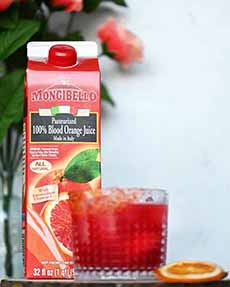
[2] Delicious blood orange juice is available from both domestic producers and imports. Mongibello blood oranges are grown at the base of Mount Etna, Sicily.

[3] The flesh of different varieties of blood orange can range from rosy pink to deep red (photo © Good Eggs).
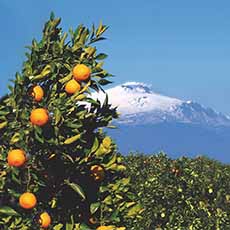
[4] A blood orange grove at the base of Mount Etna, in Sicily.

[5] Gin and Tonic, possibly the most popular gin cocktail, was developed so Brits in malarial areas of the world (like India) could swallow preventative and curative doses of awful-tasting quinine (photo © Sebastian Coman Photography | Pexels.
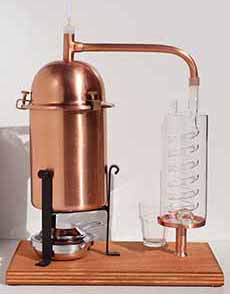
[6] The alembic still. Numerous places sell them. This one is on Etsy (photo © CAFA Italia |Etsy).
|



